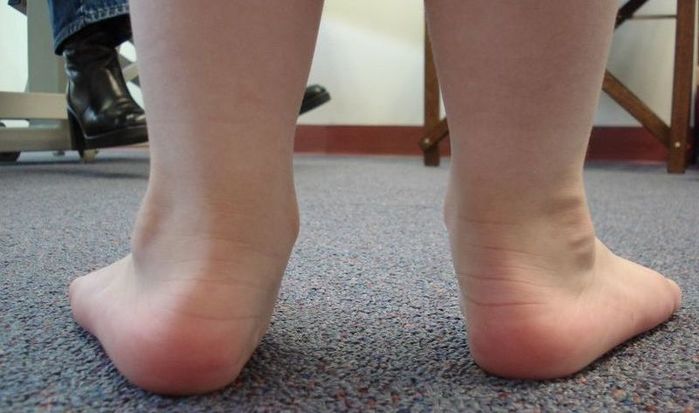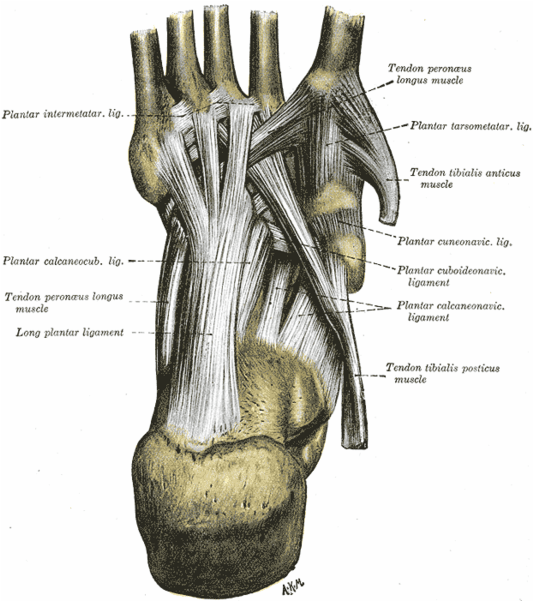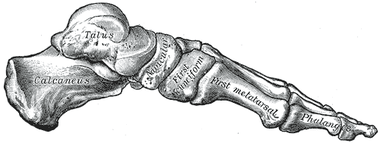PLANTAR FASCIITIS
The Plantar Fascia is a thick, dense, band of connective tissue that helps stabilize the foot and create its arches. It is anchored to the heel and runs forward to attach to all the toes, but most specifically to the big toe. If you pull up on your big toe, you will probably be able to feel a cable-like band of tissue on the bottom of the foot. This is the Plantar Fascia, and truthfully, it is much more like a tendon than fascia. As mechanical stress is put on the foot during the gait cycle (man was not designed for concrete), the arch repeatedly flattens out. The tissue that makes up the thick, ligament-like, tissue on the bottom of the foot is under continual tensile stress as the Plantar Fascia pulls at its attachment points — the base of the big toe, but more particularly, the heel. Notice in the picture above that this child is severely over-pronated.

YOU CAN SEE THE PLANTAR FASCIA ATTACHING TO THE FIRST THREE TOES
(The Lower Attachment is Where Heel Spurs Form)


BONES THAT MAKE THE FOOT’S ARCH
LEFT: Notice the attachment point of the plantar fasica on the heel. This is typically where inordiate amounts of mechanical stress develop, which causes a bone spur to form. ABOVE: Although it’s not shown in this picture, the Plantar Fascia is firmly anchored to the “knob” of bone on the bottom right part of the heel. Wolff’s Law says that, “Bone grows in response to mechanical pressures applied to it, whether normal or abnormal.” Because the Plantar Fascia shoots straight across the arch (it ‘bridges’ the arch) and attaches opposite the heel on the fist metatarsal head, there can be tremendous mechanical pressures, abnormal bone growth, as well as pain at either spot. However, it occurs more commonly at the heel.
PLANTAR FASCIITIS & HEEL SPURS
DIAGNOSING & TREATING PLANTAR FASCIITIS
If you read the previous paragraph, you understand why I do not X-ray most patient’s feet when Plantar Fasciitis is the chief suspect. This is because Plantar Fasciitis is ridiculously simple to diagnose. If you have first-step-in-the-morning pain……you’ve got it. The traditional medical approach offers us things like X-rays to tell us whether or not a heel spur is present (even though doctors have known for decades that heel spurs do not cause pain), anti-inflammation medications, CORTICOSTEROID INJECTIONS, PLATELET INJECTION THERAPY, ultrasound, artho-tripsy, and even surgery — Plantar Fasciectomy. We offer a better approach for dealing with the underlying cause of Chronic Foot Pain.
- SCAR TISSUE TREATMENT TO THE PLANTAR FASCIA, ALONG WITH SPECIALIZED STRETCHES: Stretching programs often fail because the scar tissue and calcification in the thick plantar fascia is not broken up first (see FASCIAL ADHESIONS). After the scar tissue and adhesion is dealt with, you can begin a serious stretching protocol.
- SPECIFIC ADJUSTMENTS TO THE FEET: There are more bones in one foot than in the entire spine. When these bones do not move freely in relationship to each other, the result is a continuation of the cycle of pain, dysfunction, and DEGENERATION. I practice a form of L.John Faye’s Motion Palpation Technique with a Drop Table or use an Impulse Adjusting Instrument.
- A GOOD ORTHOTIC: All orthotics are not created equal! A good orthotic that is and orthotic that is both flexible and rigid. We carry generic orthotics that will work well for many people. Plus, they’re under 50 bucks. However, for certain types of feet (particularly very high or very fallen arches), you will almost certainly require a custom orthotic (particularly with high arches). I have used numerous labs for this, but for the past decade, the only person I trust is Shawn Eno’s XTREME FOOTWERKS Lab of Idaho Springs, CO. Proper orthotics help take pressure off of the plantar fascia by essentially becoming the arch. Bear in mind that poor foot wear can certainly contribute to Plantar Fasciitis and Chronic Pain as well. Not having a properly supported foot is the number one deal breaker for solving stubborn cases of Plantar Fasciitis.
- GOOD NUTRITION: Specific nutritional supplements will not only slow down INFLAMMATION, but actually promote healing of the ELASTIC, COLLAGEN-BASED CONNECTIVE TISSUES. Along with this, you may need to lose some weight. Think about what excess weight does to your arch. HERE is the best possible way to lose weight —- particularly if you have severe heel pain.

